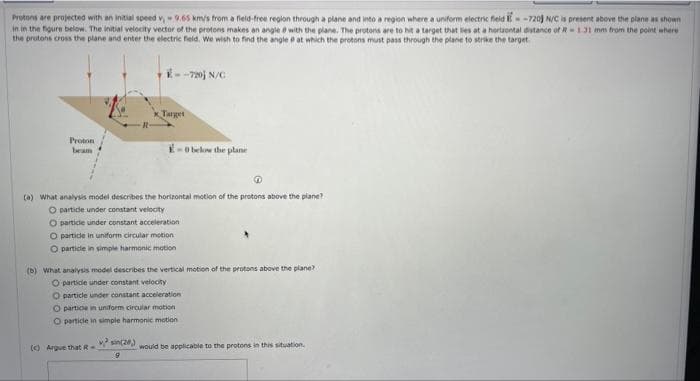Protons are projected with an initial speed v, 9.65 km/s from a field-free region through a plane and into a region where a uniform electric field --720) N/C is present above the plane as shown in in the figure below. The initial velocity vector of the protons makes an angle with the plane. The protons are to hit a target that lies at a horizontal distance of R-1.31 mm from the point where the protons cross the plane and enter the electric field. We wish to find the angle o at which the protons must pass through the plane to strike the target. Proton beam --720 N/C Target @ (a) What analysis model describes the horizontal motion of the protons above the plane? O particle under constant velocity E-0 below the plane O particle under constant acceleration O particle in uniform circular motion O particle in simple harmonic motion (c) Argue that R (b) What analysis model describes the vertical motion of the protons above the plane? O particle under constant velocity O particle under constant acceleration sin(28) 9 O partice in uniform circular motion O particle in simple harmonic motion would be applicable to the protons in this situation.
Protons are projected with an initial speed v, 9.65 km/s from a field-free region through a plane and into a region where a uniform electric field --720) N/C is present above the plane as shown in in the figure below. The initial velocity vector of the protons makes an angle with the plane. The protons are to hit a target that lies at a horizontal distance of R-1.31 mm from the point where the protons cross the plane and enter the electric field. We wish to find the angle o at which the protons must pass through the plane to strike the target. Proton beam --720 N/C Target @ (a) What analysis model describes the horizontal motion of the protons above the plane? O particle under constant velocity E-0 below the plane O particle under constant acceleration O particle in uniform circular motion O particle in simple harmonic motion (c) Argue that R (b) What analysis model describes the vertical motion of the protons above the plane? O particle under constant velocity O particle under constant acceleration sin(28) 9 O partice in uniform circular motion O particle in simple harmonic motion would be applicable to the protons in this situation.
Related questions
Question
100%

Transcribed Image Text:Protons are projected with an initial speed v, 9.65 km/s from a field-free region through a plane and into a region where a uniform electric fleid -720) N/C is present above the plane as shown
-1.31 mm from the point where
in in the figure below. The initial velocity vector of the protons makes an angle with the plane. The protons are to hit a target that lies at a horizontal distance of
the protons cross the plane and enter the electric field. We wish to find the angle o at which the protons must pass through the plane to strike the target.
Proton
beam
--720) N/C
(c) Argue that R
Target
(a) What analysis model describes the horizontal motion of the protons above the plane?
O particle under constant velocity
O particle under constant acceleration
O particle in uniform circular motion
O particle in simple harmonic motion
sin(28)
9
E-0 below the plane
(b) What analysis model describes the vertical motion of the protons above the plane?
O partide under constant velocity
O particle under constant acceleration
O partice in uniform circular motion
O particle in simple harmonic motion
would be applicable to the protons in this situation.

Transcribed Image Text:(d) Use R
proton.)
R =
v²sin(208)
9
to write an expression for R in terms of v, E, the charge and mass of the proton, and the angle 6. (Use the following as necessary: v, e, E, 6, and m, for the mass of
(e) Find the two possible values of the angle (in degrees). (Enter your answers from smallest to largest.)
(r) Find the time interval during which the proton is above the plane in the figure above for each of the two possible values of @ (in degrees). (Enter your answers from smallest to largest.)
ns
ns
Expert Solution
This question has been solved!
Explore an expertly crafted, step-by-step solution for a thorough understanding of key concepts.
This is a popular solution!
Trending now
This is a popular solution!
Step by step
Solved in 3 steps
